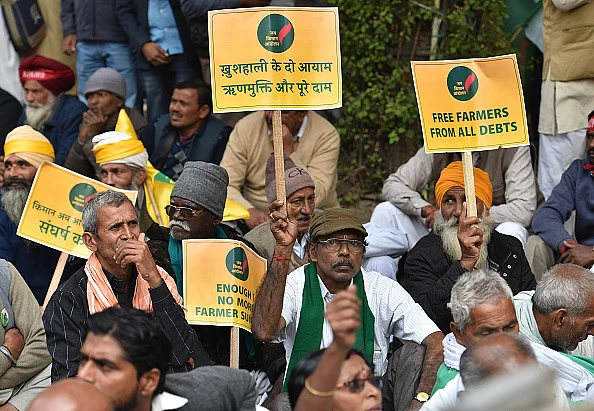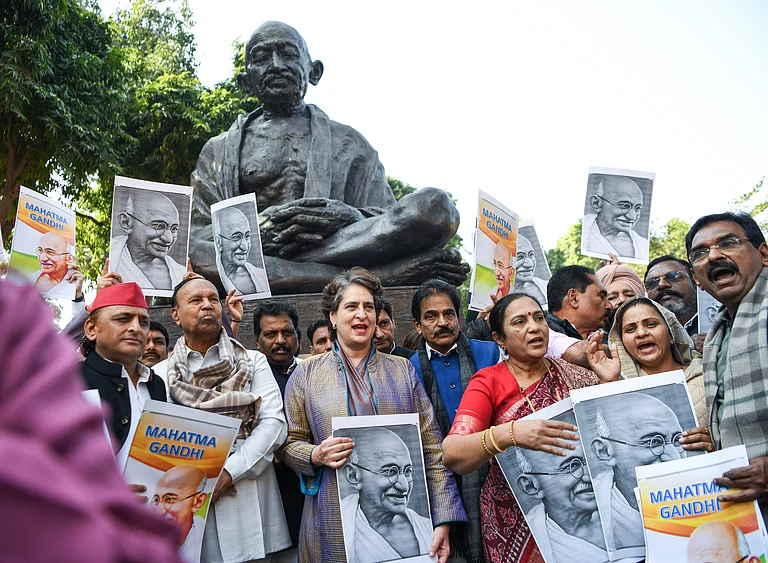The ongoing farmers' protest has put the spotlight back on the longstanding demands of India's agricultural community. A key demand that has frequently arisen over the years is the waiving of farm loans, given the high levels of indebtedness faced by the country's farming households. Despite the repeated demands, the central government has been reluctant to announce nationwide loan waivers. Since independence, there have only been two instances when the centre passed farm loan waivers.
The First Central Loan Waiver in 1990
The first farm loan waiver by the central government came in 1990 under Prime Minister V.P. Singh's National Front coalition government. The waiver was announced in the 1990-91 budget presented by Finance Minister Madhu Dandavate. It aimed to fulfil the National Front's election promise of providing relief to farmers struggling under the burden of debt.
As per the scheme, loans of up to Rs 10,000 taken by "poor farmers, artisans and weavers" were waived. The initial allocation was Rs 1,000 crore, but the final cost to the exchequer was Rs 7,825 crore. This necessitated additional borrowings by states from the RBI to fund their share. Around 3.2 crore farmers benefited from the waiver, which amounted to a third of the total outstanding farm loans.
The waiver faced criticism from the opposition for its limited coverage, with only small and marginal farmers eligible. The Congress called it "bad economics", arguing it was too small to provide meaningful relief. However, it did mark the first time the central government deployed loan waivers as a policy tool for alleviating agrarian distress.
The Mega Waiver of 2008
It took years before the next central government passed the farm loan waiver in 2008 under Prime Minister Manmohan Singh's UPA-1 regime. The 2008 scheme was unprecedented in size and scope compared to 1990.
The overarching aim was to bring relief to farmers reeling under mounting debts, defaults, and suicides. Called the Agricultural Debt Waiver and Debt Relief Scheme, 2008, it sought to waive all farm loans disbursed between 1997 and 2007 by commercial banks, regional rural banks and cooperatives.
For marginal farmers with up to 1 hectare land, a 100 per cent waiver on loans up to Rs 20,000 was provided. For other farmers, there was a 25 per cent waiver up to a maximum of Rs 20,000 per borrower. In total, Rs 52,000 crore was allocated for the scheme, covering an estimated 3.7 crore farmers.
The waiver faced criticism for excluding tenants without land titles and landless labourers. Several economists argued it could distort credit culture and affect future lending. But it proved to be a significant political move for the UPA, playing a key role in its re-election in 2009.
BJP’s Approach to Address the Issue
Unlike previous governments, Prime Minister Narendra Modi's administration has not announced any nationwide farm loan waiver scheme. However, one of its flagship programs is the PM-KISAN scheme launched in 2018. Under this scheme, small and marginal farmers with up to 2 hectares of land receive direct income support of Rs 6,000 per year paid in three instalments.
The PM-KISAN scheme was announced just months ahead of the 2019 general elections. At public rallies, PM Modi sharply criticised the Opposition parties like Congress for announcing farm loan waivers once in 10 years just to win votes by giving "lollipops" to farmers. He presented PM-KISAN as a more sustainable solution.
Interestingly, the PM-KISAN scheme was launched after Congress' victories in Rajasthan, Madhya Pradesh and Chhattisgarh in late 2018, where it had promised farm loan waivers. So, it was likely a counterstrategy by the Modi government.
State Governments on Farmers’ Loan Waiving
While central government waivers have been rare, state governments have frequently deployed loan waivers, especially prior to state assembly elections.
Haryana was a pioneer, announcing a Rs 10,000 farm loan waiver in 1987 after the Lok Dal came to power. Haryana's move encouraged other states to follow suit periodically. Kerala brought out its own Farmers' Debt Relief Commission Act in 2006 to provide case-by-case loan waivers during a spate of farm suicides.
In 2017, the Yogi Adityanath government of UP announced a Rs 36,359 crore farm loan waiver for small and marginal farmers who had loans up to Rs 1 lakh. This fulfilled a key election promise.
The same year, The Devendra Fadnavis government in Maharashtra announced a Rs 34,000 crore farm loan waiver, titled the Chhatrapati Shivaji Maharaj Shetkari Sanman Yojana. It waived loans up to Rs 1.5 lakhs.
In Karnataka, The Kumaraswamy government announced a Rs 44,000 crore farm loan waiver scheme, called the Krishapatnam Scheme. It covered loans up to Rs 2 lakhs from cooperative banks in 2018.
In Rajasthan, after coming to power, the Congress government led by Ashok Gehlot approved farm loan waivers up to Rs 2 lakhs for defaulter farmers. The estimated cost was Rs 18,000 crore in 2018.
In 2018, the newly elected Congress government in Madhya Pradesh, under Kamal Nath announced a Rs 36,500 crore farm debt waiver for loans up to Rs 2 lakhs per farmer.
In 2019, the Jagan Mohan Reddy government in Andhra Pradesh passed a bill to waive off farmer loans up to Rs 1.5 lakhs. The estimated cost of the waiver was over Rs 24,000 crore.
While farm loan waivers provide immediate relief to distressed farmers, in recent years they have been found within numerous shortcomings in implementation.
The farm loan waivers by states like Uttar Pradesh, Maharashtra and Karnataka have faced issues in implementation. In UP, nearly half the beneficiaries were found ineligible as per Comptroller and Auditor General reports. In Maharashtra, a mere 22 per cent of farmers benefited from the over Rs 34,000 crore waiver in the first year due to exclusion errors.
Karnataka saw massive farmer protests in 2020 alleging that loans were not waived. The RS 20,000 crore spent did not provide real relief. Such issues show poor targeting, leakage to the non-needy, and gaps between announcement and delivery. The RBI has noted that loan waivers disrupt credit culture and stress state finances. A CAG report on the 2008 all-India waiver found nearly half the amount was cornered by undeserving farmers.



























